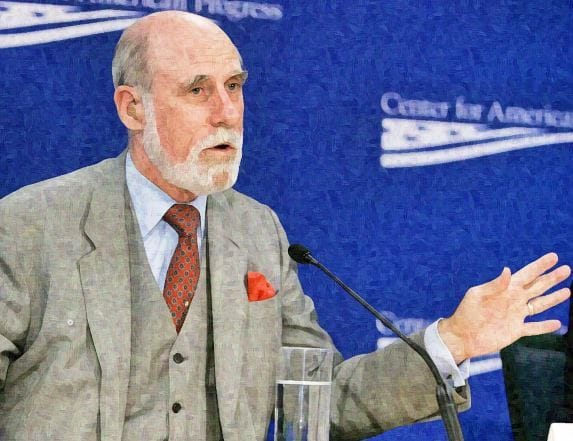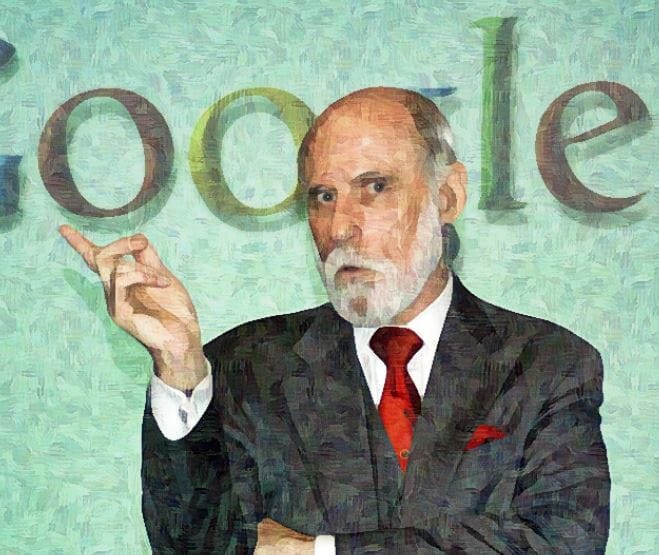Imagine a world where communication across continents happened in the blink of an eye, where the invention of a single protocol could bind the farthest corners of the globe into a single digital conversation. This vision, often taken for granted today, is the reality Vinton Cerf foresaw and helped to create. Known as one of the "Fathers of the Internet," Cerf didn’t just see possibilities where most saw limitations; he forged pathways through uncharted territories in the digital realm.

Vinton Cerf speaking at the Center for American Progress’ “The Great Debate: What Is Net Neutrality?” in 2006
But Vint Cerf's story is not only about creating the infrastructure of the internet. It’s a tale of curiosity, perseverance, and the relentless pursuit of change. His journey isn’t simply an account of technological triumphs but a blueprint of how vision and perseverance can reshape reality.
Background and Context
Vinton Gray Cerf was born on June 23, 1943, in New Haven, Connecticut, the son of Vinton Thruston Cerf and Muriel Gray Cerf. His childhood was steeped in an environment of intellectual curiosity. As a young boy, Vint began to show an early interest in the sciences, which was nurtured by his parents' encouragement and the burgeoning technological advancements of the era. Despite being raised in a nurturing environment, Vint faced a personal challenge that would shape his resilience and empathy—he was diagnosed with a hearing impairment. Rather than letting this deter him, the young Vint turned to technology as both a sanctuary and a field of exploration.
Cerf’s educational journey took him to Stanford University, where he majored in mathematics. Stanford provided the fertile ground for Vint's burgeoning interest in computer science, a field still in its infancy at the time. Encouraged by mentors and peers, he pursued a master's degree in Electrical Engineering at UCLA, where he was first introduced to packet switching networks under the guidance of Professor Leonard Kleinrock, a pioneer in the field himself. These formative years were not just about academic achievement but about cultivating a mindset ready to challenge the status quo, a theme that would resonate throughout his career.
The Challenge or Turning Point
The late 1960s and early 1970s were a period of rapid technological advancements but also one of formidable challenges. The idea of networking computers was still a nascent concept, fraught with the limitations of existing technology and skepticism from traditional quarters. One of the major challenges Vint faced was the lack of a unified communication protocol that could enable disparate networks to communicate effectively. This was not merely a technical hurdle; it required a revolutionary shift in thinking—a move from isolated systems to an interconnected web.
In collaboration with Robert E. Kahn, another visionary in the field, Cerf embarked on developing what would become TCP/IP (Transmission Control Protocol/Internet Protocol). This protocol would lay the foundation for modern internet communication. The process was not without its setbacks. Convincing stakeholders of the viability of such a system required not just technical prowess but also an ability to communicate vision and potential—a skill that Cerf had honed over years of academic and professional experience.
The Journey of Overcoming
Vinton Cerf’s journey of overcoming challenges is a masterclass in innovation and perseverance. The development of TCP/IP was a painstaking process that involved countless trials and errors, collaborative efforts across multiple disciplines, and a steadfast belief in the potential of the internet. Cerf and Kahn’s work was groundbreaking because it proposed a set of rules that would allow computers to communicate, regardless of their underlying architecture.
The journey was not solely about technical challenges. It required navigating the bureaucratic and financial obstacles of securing funding and support from various organizations, including the United States Department of Defense, which was interested in the potential military applications of such a network. Through persistence and an unwavering commitment to his vision, Cerf and his team successfully demonstrated the potential of their protocol in 1977, marking a pivotal moment in the history of technology.
Vint's personal journey also involved overcoming the social and professional obstacles that often accompany groundbreaking work. There were skeptics who doubted the necessity or feasibility of a global network. Yet, Cerf's ability to articulate his vision and demonstrate the practical applications of the internet gradually won over detractors.
Achievements and Impact
The successful development and implementation of TCP/IP was a watershed moment, not only for Cerf and Kahn but for the world at large. This protocol became the backbone of what we now know as the internet, enabling the unprecedented exchange of information and ideas across the globe. Vinton Cerf’s contribution to technology did not stop with TCP/IP. In the years following, he continued to be a pivotal figure in the development and expansion of the internet.
As Google’s Vice President and Chief Internet Evangelist, Cerf has been instrumental in advocating for internet access as a basic human right. His work has focused on bridging the digital divide, ensuring that the transformative power of the internet is accessible to all, regardless of geographic or socio-economic barriers. Cerf's commitment to innovation is also evident in his involvement with projects aimed at extending internet technology into space, thereby opening new frontiers for exploration and communication.
In 2023, Cerf was awarded the prestigious IEEE Medal of Honor, a testament to his enduring influence and the far-reaching impact of his work. His achievements have inspired a generation of technologists and innovators, fostering a culture of curiosity and a relentless pursuit of advancement.
Conclusion
Vinton Cerf’s story is not just one of technological achievement but of vision and resilience. He exemplifies the power of seeing possibilities where others see limitations and the importance of persevering in the face of challenges. His life's work has not only reshaped our world but has provided a roadmap for future innovators. Cerf's journey underscores the importance of imagination, dedication, and the courage to defy conventional wisdom—a legacy that will undoubtedly inspire future generations.
Personal Insights, Quotes, and Lessons
Today, Vinton Cerf continues to be an active advocate for digital accessibility and innovation. Reflecting on his career, Cerf often emphasizes the importance of curiosity and a willingness to take risks. "The journey of innovation is never a straight path," he notes. "It requires the courage to venture into the unknown and the resilience to keep moving forward, even when the way is not clear."
As he looks to the future, Cerf remains focused on the continued expansion of the internet's capabilities, especially in underserved regions. His work continues to inspire those who seek to harness technology not just for profit, but for the betterment of society. Through his example, Cerf teaches us that the true measure of success lies not in accolades but in the lasting impact one can have on the world.
Lessons Learned: Vint Cerf - Father of the Internet
The Visionary's Perspective:
Key Lesson: Embrace curiosity and foresight to spot opportunities and drive innovation.
Example from Their Life: Vinton Cerf foresaw the potential of a unified communication protocol at a time when computer networks were isolated and disparate. His vision for a globally interconnected internet was revolutionary and set the stage for modern digital communication
How to Apply This: Cultivate a mindset that looks beyond current limitations. Stay informed about emerging technologies and trends, and practice thinking about how they can converge to create new opportunities.
Action Step: Set aside time each week to explore new technologies or industries. Ask yourself how they might evolve over the next decade and write down at least three potential opportunities they could create.
The Competitive Edge:
Key Lesson: Develop resilience and a strong work ethic to overcome personal and professional challenges.
Example from Their Life: Despite his hearing impairment, Cerf did not let this deter his pursuit of knowledge and innovation. His determination and disciplined work ethic were pivotal in the development of TCP/IP.
How to Apply This: Identify personal challenges or limitations, and create a plan to address them through learning and perseverance. Build habits that reinforce discipline, such as setting daily goals and reflecting on your progress.
Action Step: Choose one personal challenge you face and outline three steps to overcome it. Implement these steps over the next month, monitoring your progress and adjusting as necessary.
The Strategic Risk-Taker:
Key Lesson: Balance bold innovation with strategic decision-making to achieve impactful results.
Example from Their Life: Cerf’s collaboration with Robert Kahn on TCP/IP was a significant risk, given the technical and institutional challenges. Their success was rooted in careful planning and persistent advocacy.
How to Apply This: Assess risks by understanding their potential impact and feasibility. Use a decision-making framework that evaluates benefits, costs, and long-term potential.
Action Step: The next time you face a decision involving risk, use a decision matrix to weigh your options. List potential outcomes, their likelihood, and impact to guide your choice.
The Impact-Driven Leader:
Key Lesson: Use your success to create opportunities and growth for others.
Example from Their Life: As Google’s Vice President and Chief Internet Evangelist, Cerf emphasized the importance of digital accessibility, advocating for internet as a fundamental human right.
How to Apply This: Integrate a service mindset into your professional journey. Seek opportunities to mentor others or contribute to projects that have a positive societal impact.
Action Step: Identify one community or professional group where you can contribute your skills. Volunteer regularly over the next three months and reflect on the impact of your involvement.
The Adaptive Innovator:
Key Lesson: Stay flexible and continuously learn to remain at the forefront of change.
Example from Their Life: Cerf’s involvement in extending internet technology into space demonstrates his commitment to pushing boundaries and exploring new frontiers.
How to Apply This: Regularly update your skills and seek new learning opportunities. Embrace change by welcoming new ideas and being open to pivoting when necessary.
Action Step: Enroll in an online course or workshop in an area outside your current expertise. Dedicate time each week to learning and applying new concepts to your work or projects.
By following this framework and implementing the action steps, individuals can draw inspiration from Vinton Cerf’s journey and apply these lessons to their own personal and professional growth.
Thank you for reading this edition of Modeling Winners. If you enjoyed what you read, please consider subscribing. We post inspirational stories throughout the week. The best part? It’s FREE!
If you are already a subscriber, please consider whitelisting our emails so they go directly into your primary inbox.
Want to share this specific article? Copy the link below to share:
What part of the newsletter did you like best?
📖 Reading the Biography 🎧 Listening to the Biography 🧠 Reading the Lessons Learned SectionWant to view the Modeling Winners newsletter as an app on your mobile device? Here’s how!
For iOS:
Open Safari and go to the web page.
Tap the Share button (square with an arrow pointing up).
Scroll down and select "Add to Home Screen."
Rename it if needed, then tap "Add."
The shortcut will now appear like an app on your home screen.
For Android:
Open Chrome and go to the web page.
Tap the three-dot menu (top right corner).
Select "Add to Home screen."
Rename it if needed, then tap "Add."
Choose "Add automatically" or drag it where you want.



